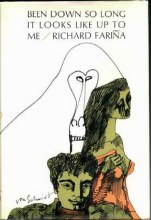The Fariña Files | home
Time Line | Cast of characters | Cast of Characters 2 | Cast of Characters 3 | This One's For Mimi | The Books - a guide | Newport Folk Festival 1965 | Dick and Mimi - where they were, how they got there, and what they did for three days | Newport Folk Festival - July 22, 23rd | Newport Folk Festival - Saturday, July 24th | Newport Folk Festival - Sunday, July 25th | Photos and Sources | Annotated Discography | Four for Fun | Web site bibliography | Favorite Links | Contact Me
Time Line
1937
|
8 March - Richard George Farina born in Flatbush, Brooklyn to Richard Farina, Sr. (the former Liborio Ricardo Fariñas, formerly of Matanzas province, Cuba; he dropped the s and the ~ when he came to the US in 1925) and the former Theresa Crozier (from County Tyrone, Northern Ireland).
|
1945
|
The family lives in a fairly modern five room apartment at 353 Linden Blvd. in Brooklyn, and Dick attends Holy Cross Catholic Elementary School. The asthmatic and highly allergic eight-year old travels to Cuba with his mother on the sickly kid's doctor's advice, to visit his father's relatives.
30 April - Margarita Mimi Baez born to Albert and Joan Baez in Menlo Park, California; she is named after her father's sister.
|
1950
|
Fall - Dick attends Brooklyn High School of Technology; his father, having a technological background convinces Dick that the future is not yet in plastics, but in engineering.
|
1954
|
Late Spring - Joan & Mimi Baez's aunt takes them to a Pete Seeger concert for the California Democratic Party; it becomes an electric moment for Joan, and both girls announce they want to be folk singers. Nine year old Mimi forgets. Thirteen year-old Joan doesn't.
Dick's accepted for the electrical engineering program at Cornell University in Ithaca, New York.
|
1956
|
December - Cornell sophomore Richard Farina is nabbed by the campus cops when he grabs a cross-
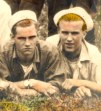 eyed Mary from a manger scene and tests her wings by heaving her over Triphammer Bridge into the gorge below. This, and several more run-ins after, marks him as a troublemaker and an easy target when the campus cops come looking for The Usual Suspects to nab as ringleaders two years later during campus disturbances. eyed Mary from a manger scene and tests her wings by heaving her over Triphammer Bridge into the gorge below. This, and several more run-ins after, marks him as a troublemaker and an easy target when the campus cops come looking for The Usual Suspects to nab as ringleaders two years later during campus disturbances. |
1957
|
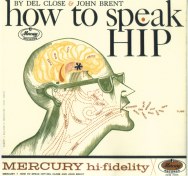 December - Farina answers his final in chemical engineering class, according to Hajdu, "with a free verse poem about why he should not be studying chemical engineering." Dunno what grade he got, but the next semester he was granted entry into the creative writing program. December - Farina answers his final in chemical engineering class, according to Hajdu, "with a free verse poem about why he should not be studying chemical engineering." Dunno what grade he got, but the next semester he was granted entry into the creative writing program. |
1958
|
March - Farina wins Cornell's undergrad short-story award for " With a copy of Dylan under my arm", which is published in the Cornell Writer (with two poems).
|
22 May - Co-ed parties barred off campus at Cornell (largely seen as a gesture against the rising tide of non-conformity and aimed at allowing all students to live an upright, moral life, by force if necessary), resulting in on-campus demonstrations led by J. Kirk Sale, a senior and editor of the campus newspaper. Also Farina's roomate at the time. As a result, the politcally-disinterested Farina only gets involved to the extent that he holds Sale's ankles at the demonstration to keep him from being dislodged from a wall by fun-seeking frat boys.
|
25 May - NYT reports "Richard Farina, a junior, of 353 Linden Boulevard, Brooklyn", J. Kirk Sale, Robert
 M. Perry, and David N. Seidler have been suspended ("Cornell drops 4 after new riots"), "on charges of having incited students to riot." It is largely thought that Farina, as a known troublemaker, was a prime target for the campus cops in their roundup of the usual suspects. The fact that he was physically on-site at the demonstration-turned-riot was just seen as further damning evidence to the fact that he was always guilty of something. (fellow fearless Revolutionary, Leon Trotsky. Storm the barricades!) M. Perry, and David N. Seidler have been suspended ("Cornell drops 4 after new riots"), "on charges of having incited students to riot." It is largely thought that Farina, as a known troublemaker, was a prime target for the campus cops in their roundup of the usual suspects. The fact that he was physically on-site at the demonstration-turned-riot was just seen as further damning evidence to the fact that he was always guilty of something. (fellow fearless Revolutionary, Leon Trotsky. Storm the barricades!) |
27 May - Cornell riot "leaders" apologize
|
1 June - All five (I thought it was only four?) resume classes, according to the NYT. And you know they can't be wrong.
|
Summer - Farina rents apartment on Linden Ave. in Ithaca with C. Michael Curtis, filled with furniture
 poached from various public rooms around the college. By the fall, fellow student Thomas Pynchon joins them. According to several sources, Dick does not graduate, and is later reported to have taken classes along with Carolyn Hester, at the University of Virginia in the early '60s.
|
Summer - Baez family moves from Palo Alto, CA to Belmont, Massachusetts, a suburb of Boston, when Albert Baez is hired by the Massachusetts Institute of Technology.
|
Fall - Mimi goes to Belmont High School.
|
1959
|
Spring - Mimi's looks begin to attract Joan's waiting room full of hopefulls; Mimi and Joan start performing together.
11 July - Joan goes to the first Newport Folk Festival hoping to get invited on stage (it could happen in those days), and finally gets the come-hither from Bob Gibson (who tours with Mimi in the late 70s). She is a gold-edged success. It is a rainy day.
|
1960
|
June - Dick meets folksinger Carolyn Hester at Gerde's Folk City in New York and is immediately intent
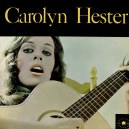 on marrying her. Two weeks later, he succeeds. They are married in St.Ambrose Chapel at the Cathedral of St, John the Divine (C.Michael Curtis is best man, Beth Sucklow is maid of honor), and have a drunken reception at NYT music critic Robert Shelton's apartment. on marrying her. Two weeks later, he succeeds. They are married in St.Ambrose Chapel at the Cathedral of St, John the Divine (C.Michael Curtis is best man, Beth Sucklow is maid of honor), and have a drunken reception at NYT music critic Robert Shelton's apartment. |
1961
|
Spring - By this time, Dick is still living in NYC and is about 100 pages into the writing of Been Down So Long. Carolyn shows him how to play her dulcimer, and very shortly after, he starts popping up on stage in wool hat and fisherman's outfit during some of Carolyn's gigs, doing traditional songs acappella.
10April - In NYC, Bob Dylan introduces himself to the visiting Baez sisters after Hoot Night at Gerde's; he sings them "Song to Woody" , tells Joan it'd be okay if she wanted to record it and then asks the surprized 16 year-old Mimi out. Joan forbids her to talk to Dylan "ever again."
May - Dick and Carolyn stay with Dick's mother, now remarried as Teresa O'Sullivan, in Brooklyn. Carolyn is signed to Columbia by John Hammond Sr. through the intervention of her manager, Charles Rothschild and Albert Grossman. Farina has a fit about Grossman's involvement, assumes Grossman, whom he considers too pushy, has ulterior motives (unlike Dick, whose motives in all things were pure).
30 September - Carolyn Hester has her first Columbia recording session, produced by John Hammond. At Carolyn's request, Bob Dylan plays harmonica & and this raises the eyebrows of John Hammond. As a result, Hammond gives Dylan an audition and signs him to Columbia, where he's known as "Hammond's Folly". Dick will claim for years that he got Carolyn the session, he invited Dylan, he'd talked up Dylan to Hammond and to the end holds a grudge that Dylan won't acknowledge this (re: "Morgan the Pirate").
|
1962
|
January - Assuming if he goes away, he can come back as somebody else, Dick tells Carolyn he's going to Europe. He sails from NY on the United States (his father pays - at this point, Fariña's income was based on what the literary journals paid for his poems and what Carolyn made). Carolyn stays in Brooklyn with Dick's mother, finishes her gigs, then follows two weeks later. Fariña, who'd been sporting a moustache up to this point in order to look more European, shaves it off in Europe, according to Hajdu, in order to look more American.
March - In London, Dick gives his first solo performance at Cecil Sharpe House. Since the bill was supposed to be Carolyn as headliner plus Clay Jackson and Peter Stanley, she quite rightly decides Fariña is basically, as Louis Armstrong used to put it, "fucking with (her) hustle", by co-billing himself as an equal. In order to make peace when the audience agrees with them as equals, Dick suggests a trip to Paris ....
April - The trip to Paris does far more for Dick than Carolyn, as it is on this trip that a mid-month communal visit to Chartres Cathedral with his fellow musical ex-pats, that Dick is introduced to the 16 year-old Mimi Baez.
The trip includes John Cooke (and his Volvo), Carolyn, Dick, Alex Campbell (a Scottish folksinger friend of them all), Mimi and her boyfriend, Todd Stuart. Dick and Mimi flirt. Carolyn steams. After another one of Dick's unsolicited critiques of Carolyn's appearance, she threatens to shoot him with his own gun. Dick is a little too agreeable to that fate, and Carolyn backs off. Divorce seems a better solution. Shortly afterwards, Carolyn flies back to the US to look for a lawyer and Dick goes back to London, where the 25 year old strikes up a prodigious correspondence with the just-turned-17 Mimi, which continues for the next year and a half.
July - Allegedly, Carolyn returns to Europe, and they head for Pamplona and the Running of the Bulls. The photos show a happy couple. Or perhaps just a slightly tiddly one trying to pretend things are all rosebuds for five minutes.
September - 3rd-8th - Mimi convinces her family to send her to a Quaker camp in Edinburgh as a pre-arranged chance to meet up with Dick without her family knowing. Dick and Carolyn Hester (who returns to the marriage for this previously booked gig, figuring to give things one last try) perform at Edinburgh International Festival, Edinburgh, Scotland; listed as "Plain Song and All That Jazz" , hosted by Rory and Alex McEwen, it featured Al Fairweather - Sandy Brown All-Stars and George Melly, Carolyn Hester and Dick Farina (I'm assuming they meant the untilda-ed "n" , since they had an international bevy of performers and fearlessly used just about every diacritical in the book for their listed roster and I'm sure could have scared up an ñ had Dick insisted), "and guest stars." This time period also signals the end of Dick and Carolyn's marriage. But I believe it was about this time that Farina officially became Fariña. Carolyn and Dick are together long enough to record a four-song EP with Alex and Rory McEwan in Edinburgh. And Carolyn goes back to the states, having decided a Mexican divorce would be much quicker. Fariña returns to Paris.
31 December - After months of letters from Fariña trying to lure him to London, Eric von Schmidt, his marriage crumbling and no place to paint, answers the siren song, jumps a plane to London and stays with Dick at the home of painter Rory McKuen.
|
1963
|
January - Fariña's novel is now over 200 pages long. He claims to be writing a film script for Dylan - a western - but this never appears. He is also performing publicly on the dulcimer. Dick and Carolyn give up and finally get that Mexican D-I-V-O-R-C-E , and you know that means...
|
1 January - Fariña comes to London from Paris.
|
14 January - Fariña, von Schmidt and Ethan Signer begin recording Dick Fariña & Eric von Schmidt , in the basement of Dobell's Jazz Record Shop in London, to be released in the UK only Folklore Records (see also : Discography ); joined late by Bob Dylan, they all go out, get drunk and invade the stage of the Troubador. According to noted Dylanologist Ian Woodward, in addition to Fariña's "Xmas Island" , "Riddle Song" (an adaptation), "London Waltz", and "Old Joe's Dulcimer", all of which appeared on the LP, his song "Almond Joy " (which wouldn't appear until 1968), was also an outtake and possibly copyrighted at the time (although no 1963 record exists in the Library of Congress copyrights).
|
15 January - Fariña and von Schmidt are joined on time by Bob Dylan (who will appear on the LP as Blind Boy Grunt) and the record is finished. This night they adjourn to Bunjies Coffee House.
|
16 January - Both Von Schmidt and Dylan fly back to the states.
|
Mid-January - Fariña returns to Paris, staying with friend Tom Costner.
|
Spring -Fariña lives in Paris full time, near to Mimi and her family. He writes nonstop. He scripts fairy tale plays for release as kids' records, also acting in some of them: Rumpelstiltskin, Alice in Wonderland (for which Dick convinces Joan, Sr. , Mimi's mother, to act as the Queen of Hearts to Dick's White Rabbit), Davy Crockett (on which he also plays dulcimer) and Hansel & Gretel are released in the US on United Artists in the Tale Spinners For Children series .
|
March - After months of trying to gain approval, Dick formally asks Albert Baez for permission to marry Mimi. Flattered and impressed with the upstart's manners (and knowing Mimi's 18th birthday was only weeks away), permission is granted. A summer wedding in Carmel, California is planned. Several months after Mimi's 18th birthday
|
April - Somewhere about the middle of the month, although it makes sense closer to the end of the month, which would be Mimi's 18th birthday (the 30th), Mimi Baez and Richard Fariña are secretly married at town hall in Paris.
|
4 April - Joan and her older sister Pauline work together on a song, "Tears In My Eyes", with words and music contributed by both and the copyright is registered on this date. Later this same year, Pauline would co-write two songs with her brother-in-law, Dick ("A Song For Some of Us", and "Pack Up Your Sorrows"), which would be copyrighted early in 1964.
|
May - Dick Farina and Eric von Schmidt is released on Folkways Records in the UK.
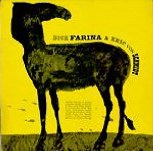 Dick Farina & Eric von Schmidt ; Folklore Records (mono, UK only), F-LEUT / 7, produced by Tom Costner - cover by von Schmidt
|
June - The dyslexic Mimi graduates from high school in Paris, thanks in part, according to Hajdu, to Dick - who wrote her book reports.
|
21 June - Dick and Mimi set sail for NYC on the France. It takes five days. They live with Dick's father and step-mother for a short time in Brooklyn.
|
August - The Fariñas drive across country and land in Carmel Valley, California, where Joan lives. Mimi stays with Joan (who'd just railroaded in with Betsy Siggins) and Dick sleeps in a one-room cabin next door. Legend has it that Albert Baez didn't leave his room for several days before the wedding, and that a large number of those assembled would have been happier with a lynching.
|
21 August - Fariña, Joan Baez, along with her friend and assistant, Kim Chappell, Betsy Siggins, best man Thomas Pynchon and several others head for the Monterey County Fair for some rest and relaxation. Mimi stays behind with what would larter turn out to be appendicitis.
|
24 August - The wedding takes place at the Baez family's rented house in nearby Portola Valley. Thomas Pynchon is best man. The Fariñas perform together in public for the first time, playing "Old blue". Shortly afterward, the Fariñas, broke and with the better part of the Baez family not speaking to them, start playing music seriously together to while away the time Dick doesn't spend writing his novel. They
 move into the cabin where Dick had been staying - Brett Weston's dinky converted photo studio, next door to Joan (said to be 10 De Los Helechos in Carmel Valley). About this time, in an effort to win over Joan, Dick suggests they do a book together, combining his series of "Little nothing poems" with her drawings to illustrate them. Efforts are made on both sides, but little comes of it. move into the cabin where Dick had been staying - Brett Weston's dinky converted photo studio, next door to Joan (said to be 10 De Los Helechos in Carmel Valley). About this time, in an effort to win over Joan, Dick suggests they do a book together, combining his series of "Little nothing poems" with her drawings to illustrate them. Efforts are made on both sides, but little comes of it.(photo 2008 by Steve Kirtley)
|
12 October - The Fariñas attend Joan's Hollywood Bowl concert, driving down in Joan's XKE with
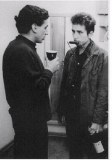 Dylan. Dick suggests to Life magazine that he's Dylan's designated writer for a proposed photo essay; the idea sinks in November when Time magazine outs Bob Dylan as Robert Zimmerman of Hibbing, Minnesota, and Dylan sours considerably on the creative powers of the press. Dylan. Dick suggests to Life magazine that he's Dylan's designated writer for a proposed photo essay; the idea sinks in November when Time magazine outs Bob Dylan as Robert Zimmerman of Hibbing, Minnesota, and Dylan sours considerably on the creative powers of the press.(photo by Barry Feinstein)
|
November - Hajdu quotes NY Times music critic Robert Shelton as saying Fariña told him at this time he'd written "a carload" of songs. Joan, thinking his stuff not half-bad, records 5 songs as demos for Maynard Solomon (head of Vanguard), who signs Dick to a songwriting contract for Ryerson Music Publishers (which is later to prove the undoing of the Fariñas' offer to sign with Elektra).
|
1964
|
January - Joan adds Dick's songs "Birmingham Sunday" and "Pack Up Your Sorrows" to her concert set. At this point, Dick copyrights two songs - "The falcon" and " A song for some of us", an unreleased song co-written with Mimi's oldest sister, Pauline Marden.
|
12 February - Copyrights come through for three more songs : "Birmingham Sunday" , the unreleased "Sombre Winds" , and "The Quiet Joys of Brotherhood" (later cited as one of Mimi's favorites). All are catagorized as "new words set to traditional music."
|
23 February -Joan and Fariña travel to Berkeley where they meet up with Dylan. Dick plays his songs for Dylan.
|
27 April - The last of Dick's fall '63 self-proclaimed "carload of songs" finally makes its way through the copyright process : "The ballad of three nasty lovers" and " A sailor's song" are - as usual for contemporary folksingers at this point,- new words to traditional melodies, "Lemondade lady", which is first to have words and music by Fariña, and "Pack Up Your Sorrows" credited to Fariña and sister-in-law Pauline Marden, with both listed as co-authors of the words and music.
|
June - Dick and Mimi's first public performance - they appeared at the first Big Sur Festival, begging off
 an encore because they didn't know any other songs. Jac Holzman, head of Elektra Records attends and immediately offers to sign them up. It gets put on hold so Dick can check with Vanguard (to whom he's contracted as a songwriter) and Mimi can run it past Joan. an encore because they didn't know any other songs. Jac Holzman, head of Elektra Records attends and immediately offers to sign them up. It gets put on hold so Dick can check with Vanguard (to whom he's contracted as a songwriter) and Mimi can run it past Joan.(photographer unknown)
|
June - Fariña, never a good driver, dumps Mark Spoelstra's motorcycle at a slow speed, while trying to make a left onto a small road. While he isn't hurt, it still gives shivers in retrospect.
|
Summer - Dick writes, Mimi gives dance lessons, both practice their songs together, while Mimi learns autoharp. They move to the Carmel Highlands, renting another somewhat larger cabin nearer to Joan. They also get their German Shepherd, Lush, from the local animal shelter during this summer. Joan suggests they're good enough to record. A demo is recorded shortly after Big Sur and sent off to Vanguard, who accept it, unbeknownst to Jac Holzman at Elektra, who's still waiting for an answer to his offer. Joan suggests Manny Greenhill, her manager, for the Fariñas. Secretly, Dick now prefers Albert Grossman (having obviously overcome his 1962 objections to Grossman's possible managing of Carolyn Hester). Now, it's Mimi who hates Grossman. (And it's quite possible that Dick made a deal with Grossman and secretly signed a publishing agreement at this point with Witmark Publishing, a Grossman-related outfit connected to Warner Brothers, and home to his clients, Peter, Paul & Mary).
|
23-26 July - Joan performs at Newport Folk Festival, accompanied by the non-performing Mimi. Dick drives across country with his buddy Alfredo Dopico to meet up with Mimi and Joan in Manhattan. Joan closes the opening night concert with Dick's "Birmingham Sunday".
|
July-August - Baez, Dylan and the Fariñas house-sit for Albert Grossman in Woodstock, NY at Dylan's invitation. They stay for a month, and Dylan and Fariña work separately but compare notes now and then. Only when Dylan AND Joan are both gone, do Dick and Mimi practice their songs.
|
September - Their first album,
|
26 September - Club 47 in Cambridge, Mass. with Mitch Greenhill as supporting act; the date was successful enough to earn Dick and Mimi a monthly Monday night slot .
|
late September - They decide to move to Cambridge, Massachusetts from the Carmel Highlands, where they will live on the Vanguard advance and Dick's songwriting income from his new contract with Witmark Publishing. Once set up in Cambridge, Dick goes back to writing and Mimi goes to the Boston Conservatory to study dance. Dick writes to von Schmidt that herds of people are still shunning them, refusing to speak to either Dick or Mimi out of some odd and probably misunderstood loyalty to the Baez family (of which Mimi was still a member, so....). The policy enrages Fariña friends like Maria Muldaur - for life.
|
19 October - 1st batch of copyrights come through for the completed Celebrations album, including several not included in the finished LP : "Almond joy", "Another country", "Reno, Nevada", "Joy 'round my brain", "Good King Jubilee" (working title for the album's title track), and "Downtown" . "A swallow song" was also among those registered at this time, though it would not be released until their second album, some seven months later. Missing in action are the copyrights for "V.", "Dog blue", and "Tuileries", as well as any notation of the title change from "Good King Jubilee" to "Celebrations for a gray day" (although this could be explained away by Fariña already owning copyright on this title through his 1961 poem for Carolyn Hester - copyrighted 14 February, 1961 -, "Celebration for a grey day", noting the differnt spelling for gray).
|
12 November - Copyright for unrecorded song, "Galway shawl", registered to Dick, published by Sanga Music.
|
1965
|
January - Fariñas are still living in Cambridge; their first album has been recorded and is being mixed and prepared for a March release. Dick Waterman remembers hanging out with Dick at this point, sitting up til all hours, talking and eating donuts. He also recalls Dick and Mimi doing a concert at an all-girls school somewhere in New England, where Dick was expressly forbidden to sing a song he'd written about a chastity belt (which is probably the same one he'd been doing off and on since 1963) - naturally, the target was too wide for Dick to miss, so the song was sung; the school's administrators are shocked... and stunned... Dick was extremely happy.
|
25 January - More copyrights are registered : "Michael, Andrew, and James" (from the 1st album), "Raven girl" (to be recorded for their next album), and "One-way ticket" (from the first album).
|
30 March- mid-April - Mimi and Richard arrive in Manhattan to record two songs with Judy Collins. Staying in her Upper West Side apartment; they record Dick & Pauline Marden's "Pack up your sorrows" and the traditional "Carry it on", with Dick on dulcimer and Mimi on guitar. Dick gets his book, Been Down So Long It Looks Like Up To Me signed
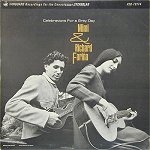 with Random House, and receives a $5400 advance (in three installments). with Random House, and receives a $5400 advance (in three installments). Their album, Celebrations For a Grey Day is released.
Dick and Mimi are said to be working on a one act play, according to Hajdu, to be produced in Cambridge by the Image Theatre Workshop (this could be the same play noted in the short bio on Celebrations, titled The Shelter, which by the 1990s, not even Mimi could locate.)
Celebrations for a gray day , Vanguard Recording Society : VRS-9174, mono / VSD-79174, stereo ; produced by Maynard Solomon - cover photo by Kenneth Van Sickle, design by Jules Halfant
|
late April - With Mimi's 20th birthday coming up, they celebrate at the Cafe Expresso in Bearsville, NY with Joan Baez, Bob Dylan, Dick's friend Alfredo Dopico, Dylan's friend and road manager Victor Maimudes and various other friends. Dylan decides to put Alfredo in his verbal sites and after a few minutes, a livid Alfredo stomps off, followed by an apologetic Dick; to fill in the time. Dylan then goes after Joan, who departs in tears leaving Bob a happy and successful practitioner of his particular art - until an equally livid and unamused Mimi lights into Dylan, grabbing a handful of hair and pulling his head back until the tears come rolling down. She suggests that Dylan should find his amusements elsewhere in future. He keeps this counsel for about a week, when he wisely puts the Atlantic Ocean between himself and Mimi before unwisely renewing this sporting event with his sidekick Bob Neuwirth when he takes Joan on his British tour, as documented in Don't Look Back. Mimi's thoughts on the morality of murder are not recorded when she later sees the film.
|
1 May - After taking the NYC-bound Joan to the train station in Poughkeepsie, Dick and Mimi head south and meet up with photographer Dan Kramer in the town of Kingston, NY, for the photo session that would yield the cover of their second Vanguard album, Reflections in a Crystal Wind, and the photos illustrating The Richard Fariña Songbook.
|
11 May - Joan Baez and Kim Chappell co-copyright an early version of "All the world has gone by", with words by Kim and music by Joan. Dick will later add, subtract or juggle words and the song will be recopyrighted by Mimi on 19 November, 1968.
|
2 June - Club date, New Gate of Cleve in Toronto. Six people show up.
|
July - Dick and Mimi record three songs for an Elektra "Project" album, The Singer songwriter project ("Birmingham Sunday", "House un-American blues activity dream", and "Bold marauder" - the
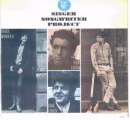 first was Dick's song and had been part of their set list since they started, the other two would be rerecorded shortly for the second Vanguard album). Though both Dick and Mimi play on the Elektra session, it's billed as a solo effort. first was Dick's song and had been part of their set list since they started, the other two would be rerecorded shortly for the second Vanguard album). Though both Dick and Mimi play on the Elektra session, it's billed as a solo effort. |
5 July - That month's Monday night spot for them at Club 47 in Cambridge
|
22 July - Arrive in Newport, Rhode Island with various Baezes, for that evening's opening of the Newport Folk Festival. They stay at the Hotel Viking, the hotel traditonally used for festival performers.
|
23 July - Newport Folk Festival - With no performances scheduled, the Fariñas wander the folk festival grounds and try some of the rides.
|
24 July - Newport Folk Festival - Fariñas perform twice , first in the field known as Area 2 at the 11:00 AM Contemporary Song Workshop, hosted by Peter Yarrow. With time limiting each performers' set (seven acts in two and a half hours), the Fariñas perform four songs including one of Dick's longer
 versions of his story intro to "House Un-American blues activity dream". At 3:00, they perform again, this time at Jean Ritchie's Dulcimer Workshop, along with Beth Van Over. With only an hour for all three performers, time passes quickly, with Dick and Mimi performing last, joined onstage by Bruce Langhorne and Al Kooper; they do five songs on their own and join Jean Ritchie in a Q & A session with the audience, followed by an ensemble performance of the traditional song, "Shady grove". (photo 1965 by Ed Grazda) versions of his story intro to "House Un-American blues activity dream". At 3:00, they perform again, this time at Jean Ritchie's Dulcimer Workshop, along with Beth Van Over. With only an hour for all three performers, time passes quickly, with Dick and Mimi performing last, joined onstage by Bruce Langhorne and Al Kooper; they do five songs on their own and join Jean Ritchie in a Q & A session with the audience, followed by an ensemble performance of the traditional song, "Shady grove". (photo 1965 by Ed Grazda) |
25 July - Newport Folk Festival - Scheduled to perform mid-afternoon at the New Folks concert, the
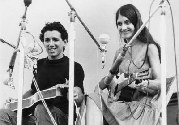 Fariñas come on next to last, just in time to have their audience swamped by a sudden thunderstorm. The audience seems happy with the arrangement and stays in place and the Fariñas do their best to reward their loyalty, playing seven songs despite a wet stage, wet audience, wet performers and the brief danger of electrocution. They get a thunderous applause. That night, both join in the closing sing along. Still glowing from their afternoon success, Dick slings their victory over the fenders and drives back to Cambridge. Fariñas come on next to last, just in time to have their audience swamped by a sudden thunderstorm. The audience seems happy with the arrangement and stays in place and the Fariñas do their best to reward their loyalty, playing seven songs despite a wet stage, wet audience, wet performers and the brief danger of electrocution. They get a thunderous applause. That night, both join in the closing sing along. Still glowing from their afternoon success, Dick slings their victory over the fenders and drives back to Cambridge. |
August - They return to Carmel at Joan's invitation, living in a small house on Mt. Devon Dr., to help out with her Institute For the Study of Non-Violence; Dick does the cooking and Mimi teaches dance. Dick and Joan spend numerous evenings at local zoning commision meetings dazzled by the array of locals indulging in paranoid rants and ravings over the nature of the Institute; the prospect of teaching peace and non-violence seeming to encourage the opposite reaction with conservative locals. Rising up and dumping the Institute in the sea is one of the more polite and least violent recourses suggested.
|
24 September - Perform twice at Carnegie Hall (two shows - 8 and midnight) in NYC in the "Sing-In For Peace In Vietnam", the invitation being wangled for them by Joan Baez . After the second concert, Baez, the Fariñas, Bernice Reagon, Theo Bikel, Pete Seeger and others head for the nearby Village Gate to get the party going, performing and giving anti-draft counseling.
Fariñas also record their second album, Reflections in a crystal wind in NYC, again at Olmsted Studios in Manhattan over several days in the last week of the month.
|
September - Elektra "Project" album, The Singer
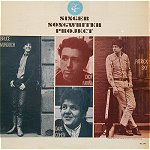 songwriter project " is released by Elektra, including three previously unrecorded songs by Dick. In keeping with the format of the album, only the singer/songwriter is credited with the performance, and accompanists are given a generic credit. Dick's accompanist was long-suspected to have been session-guitar ace, Bruce Langhorne, Dick and Mimi's recording and Newport partner in crime - but the work was done by an unbilled Mimi. songwriter project " is released by Elektra, including three previously unrecorded songs by Dick. In keeping with the format of the album, only the singer/songwriter is credited with the performance, and accompanists are given a generic credit. Dick's accompanist was long-suspected to have been session-guitar ace, Bruce Langhorne, Dick and Mimi's recording and Newport partner in crime - but the work was done by an unbilled Mimi. Singer songwriter project : Elektra Records ; EKL-299, mono / EKS-7299, stereo ; produced by Jac Holzman - cover photos by David Gahr, design by William S. Harvey
|
November - Release date of the Fariñas' second LP, Reflections in a crystal wind, although some early
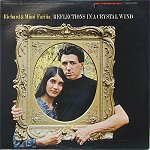 pressings will have "Dec.65" handwritten into the run-off groove rather than the normal "1A" used to denote Vanguard first pressings. pressings will have "Dec.65" handwritten into the run-off groove rather than the normal "1A" used to denote Vanguard first pressings.Reflections in a crystal wind, Vanguard Recording Society : VRS-9204, mono / VSD-79204, stereo ; produced by Maynard Solomon - cover photo by Dan Kramer, design by Jules Halfant
|
1966
|
15 February - Dick and Mimi fly from San Francisco to New York City, and take up east coast
residency for the next six weeks, living in Cambridge and subletting from Tom Rush on Putnam Ave.
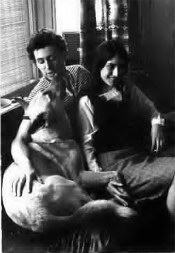 Dick and Mimi living high (2nd floor) on Putnam Street with Lush, their German shepherd - Dick wears the same shirt he had on at Newport, pictured in the Dave Gahr photo on the back cover of Memories . It's obvious "get down off the couch!" was not vocabulary in this household. photo, January/February, 1966 by Dick Waterman Dick and Mimi living high (2nd floor) on Putnam Street with Lush, their German shepherd - Dick wears the same shirt he had on at Newport, pictured in the Dave Gahr photo on the back cover of Memories . It's obvious "get down off the couch!" was not vocabulary in this household. photo, January/February, 1966 by Dick Waterman |
18-20 February - Dick and Mimi do club dates on the east coast, including this three nighter at The
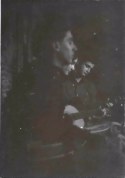 Main Point, in Bryn Mawr, PA - it snows and the audience turnout is effected, but the intrepid future rock critic Paul Williams shows up, handing Dick a copy of the just-released Pack Up Your Sorrows single to autograph. Dick remarks he didn't even know it had been released. After the second show, the Fariñas head into nearby Philadelphia to sit for an interview and perform song requests with local folk dj, Gene Shay, on his long-running Folklore program on WHAT-FM. It is recorded and several years later is the only tape missing from his library ("And it was a good one too, as I remember", he says). Main Point, in Bryn Mawr, PA - it snows and the audience turnout is effected, but the intrepid future rock critic Paul Williams shows up, handing Dick a copy of the just-released Pack Up Your Sorrows single to autograph. Dick remarks he didn't even know it had been released. After the second show, the Fariñas head into nearby Philadelphia to sit for an interview and perform song requests with local folk dj, Gene Shay, on his long-running Folklore program on WHAT-FM. It is recorded and several years later is the only tape missing from his library ("And it was a good one too, as I remember", he says). Club 47, Cambridge, Mass., Feb. '66 with Geoffrey Muldaur - photo by Dick Waterman
|
Mid-February - Dick and Mimi tape an appearance in NYC for Pete Seeger's Rainbow Quest program. It airs 26 February in its home town, so must have been taped between the 20th, when they left Philadelphia and the 26th, when it aired.
|
26 February - The Fariñas perform at Boston War Memorial for the Boston Winterfest, in what is billed as a "Folk Battle." This oddity pits Dick, Mimi, Phil Ochs, Tom Paxton and just about everyone else on the bill against an ill-scheduled Staff Sgt. Barry Sadler, whose hymn to the Green Berets had just made number 1 the week before. It would hold this position for an unnerving 5 weeks. Sadler performs 4 songs and the war drags on...
|
March, 1966 - Dick and Joan Baez get together when Dick talks her into recording a whole album's worth of
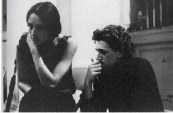 arranger, into the proceedings to try and salvage things; Grady Martin has since testified that Fariña seemed to know exactly what he was doing, what he wanted and how to get it in the studio. The album, recorded in the last two weeks of March at Dick's apparent favorite studio, Olmsted in New York City, reportedly features 3 songs by Fariña ("Pack up your sorrows", "Swallow song", "All the world has gone by"), five by Burt Bacharach (including "Anyone who had a heart" and "What the world needs now"), two by Dylan and one by Paul Simon ("Sounds of silence") and a Van Morrison ("Brown-eyed girl"), but is dropped after Dick's demise and Baez herself spends several years explaining why she was never crazy about the idea in the first place (" the criticism should be ghastly", and later said " I still cringe when I hear some of them"). arranger, into the proceedings to try and salvage things; Grady Martin has since testified that Fariña seemed to know exactly what he was doing, what he wanted and how to get it in the studio. The album, recorded in the last two weeks of March at Dick's apparent favorite studio, Olmsted in New York City, reportedly features 3 songs by Fariña ("Pack up your sorrows", "Swallow song", "All the world has gone by"), five by Burt Bacharach (including "Anyone who had a heart" and "What the world needs now"), two by Dylan and one by Paul Simon ("Sounds of silence") and a Van Morrison ("Brown-eyed girl"), but is dropped after Dick's demise and Baez herself spends several years explaining why she was never crazy about the idea in the first place (" the criticism should be ghastly", and later said " I still cringe when I hear some of them"). |
13 March - Dick and Mimi join Joan Baez on stage (" and I hope they won't steal the whole show") after intermission at Philharmonic Hall in NYC, for five songs, which is privately recorded : they play accompaniment to two of Joan's songs and then are given the stage to perform House Un-American Blues Activity Dream and Pack Up Your Sorrows, then joining in while Joan sings "te Ador" . Dick gives his usual rambling intro to their first song : ".... a couple of years ago, we heard about a guy who was having a lotta trouble with his mind. During election year, he was confusing the presidential candidates: he was seeing in his mind's eye Barry Goldwater with Lyndon Johnson's ears - surrounded by two or three battalions of SPARs and WAVEs carrying chocolate-covered donuts. Very irrational combinations of things. And he took a vacation. He was very poor and the only place to go was Cuba, because they were giving away free trips," (laughter), " And he was a pacifist and he heard there was going to be a war on poverty and he needed some time in the sun" (more laughter). "So he went down there, and while he was there, he checked in at American Express and there was a note from the House Un-American Activities Committee, which said 'C'mon home, son! ' in so many words, and he did. And when he was testifying in Washington, he was dragged off the stand by a member of the American Nazi Party. That's a true story, I read that in the New York Times! That happened! And when he was in the hospital, he was cited for contempt of court" (big laughter). "Along with everybody else, he thought it was kind of funny. And so, this is a song about that, and we'd like to dedicate it to the memory of Barry Goldwater. And you're free to dance if you want - it's a waltz and it's called : House Un-American blues activity dream". The song was played at a volume of 11, with Joan playing along and singing, while Dick sang and stretched words all around the melody. After thunderous applause, Mimi can be heard asking Joan about the apparent departure of another, unknown, woman from the stage - "Joan?" she asks, "She gone?" To which Joan says "yeah." "Bitch!" says Mimi. Dick next introduced "Pack up your sorrows" by explaining " Mimi and Joannie have another sister, Pauline, and I worked with her on this next song. Like to dedicate IT to the memory of Staff Sargeant Barry Sadler .... And you can help out on the chorus, but not on the verses.... unless you've got your Green Beret with you !" He comes back after a chorus to invite the audience, at least those without a Green Beret to do it for them, to sing along. " That's 'If someHOW you could pack up your sorrows, and give them all to me, you would lose them, I know how to use them, give them all to me - ' ; we'll play it a little bit slower - it's a kind of contemporary masochistic attitude .... Try it once with us - ". Though the tape is very bad quality and was edited during the performance, it's clear that after a tune-up, the Fariñas performed at least one more song, "te Ador", with Joan, and then vanish from the tape.
|
Early April - The Fariñas return to California to get ready for the publication of Dick's novel, Been down so long it looks like up to me. According to Hajdu and folklore, they fight constantly and things are tense
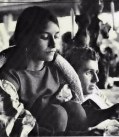 . Judy Collins Songbook says that Dick was encouraging Mimi to branch out and do things on her own at this point - to become more independent, following her training in dance and learning to drive. But Mimi also saw this, in her interviews with Hajdu, as Dick trying to get rid of her, trying to move her away from his areas of life. As always, anything Dick did can and was interpreted positively and negatively, depending on the personal view and background of his audience. . Judy Collins Songbook says that Dick was encouraging Mimi to branch out and do things on her own at this point - to become more independent, following her training in dance and learning to drive. But Mimi also saw this, in her interviews with Hajdu, as Dick trying to get rid of her, trying to move her away from his areas of life. As always, anything Dick did can and was interpreted positively and negatively, depending on the personal view and background of his audience.Dick and Mimi in Carmel, California , April 1966 ; photo by Jim Marshall from the booklet to Joan Baez' First 10 Years album
|
15-17 April - Fariñas appear at the 5th annual San Francisco College Folk Festival , along with old friends
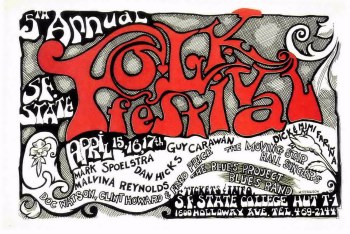 Mark Spoelstra and Al Kooper (with the Blues Project), Newport '65 veterans The Moving Star Hall Singers, the always excellent Malvina Reynolds, Doc Watson, Guy Carawan and a solo Dan Hicks! Mark Spoelstra and Al Kooper (with the Blues Project), Newport '65 veterans The Moving Star Hall Singers, the always excellent Malvina Reynolds, Doc Watson, Guy Carawan and a solo Dan Hicks! The addition of the blatantly rock-oriented Blues Project was a sign of the shift in what was considered folk. That year's Berkeley Folk Festival, beset by monetary and attendence problems in 1965, features, in addition to Pete Seeger, Malvina Reynolds and Robert Pete Williams, the recently formed Jefferson Airplane (just signed to RCA) and Country Joe and the Fish. The short-lived Folk-Rock genre was about to take its politics and lyrics and mutate into the Underground.
|
April - mid-to-late : Random House throws a publication party for Dick in their office at 457 Madison Ave. in New York City. Dick insists there be music and dancing, and enlists his friends, the Chambers Brothers, as the house band.
|
19 April - Been Down So Long It Looks Like UpTo Me, the novel the novel Fariña had worked on since 1960, is copyrighted.
|
|
published by Random House - this was the reported date anyway - books usually have official publication dates, though it's usually an arbitrary day, standard for that month's releases: shipping dates usually determine the first availability of the book. (First editions of the novel have "4/2/66" printed on the dust jacket's front flap, supposedly indicating a possible earlier pub date, but more likely just what's known as a first edition "point" for later rare booksellers to fight over.) This date also marks another batch of copyrights suddenly passing through the Library of Congress, giving this backlog 's sudden movement what's known as the "pig-in-the-python syndrome", with five titles emerging : "Hard loving loser", "House un-American blues activity dream", "Sell-out agitation waltz", "Bold marauder", and "Children of darkness", all from Reflections in a Crystal Wind.
Copyright registered for "Reflections in a crystal wind".
|
30 April - Mimi's 21st birthday. The Fariñas are scheduled for an outdoor book signing at the Thunderbird Bookshop, the hometown bookseller
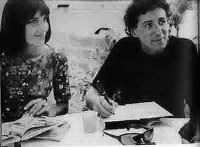 in Carmel, owned by Jim Smith, then inhabiting a coverted hay barn (relocated in the 70s to The Barnyard). Dick signs dozens of copies ("Zoom! Richard Fariña") of the just published Been Down So Long . After the signing, they head for a birthday party secretly arranged for Mimi by Dick at Mimi's sister Pauline's nearby house. During the party, Dick spots a Harley-Davidson parked outside, finds the owner, and always looking for kicks, asks for a spin. He does not survive the crash. Hajdu relates that over a week later, Mimi finally returns to their cottage to find Dick had left her a birthday card, now-wilted orange roses and a pair of shoes she'd spotted on an earlier shopping expedition... in Carmel, owned by Jim Smith, then inhabiting a coverted hay barn (relocated in the 70s to The Barnyard). Dick signs dozens of copies ("Zoom! Richard Fariña") of the just published Been Down So Long . After the signing, they head for a birthday party secretly arranged for Mimi by Dick at Mimi's sister Pauline's nearby house. During the party, Dick spots a Harley-Davidson parked outside, finds the owner, and always looking for kicks, asks for a spin. He does not survive the crash. Hajdu relates that over a week later, Mimi finally returns to their cottage to find Dick had left her a birthday card, now-wilted orange roses and a pair of shoes she'd spotted on an earlier shopping expedition...Photo: last one - Thunderbird Bookshop, Carmel, mid-afternoon, 30 April, 1966. Dick is wearing the gold braclet given to him by Joan Baez (bottom right). Photo was used by a local paper, probably the Carmel Pinecone, in their weekly issue, first week of May, along with an article on the accident and death of Richard Fariña
|
1 May - Scheduled second book signing at the Discovery Bookshop in San Franscisco, several doors
and an alleyway downhill from City Lights Books. A black and white reproduction of the original orange poster is later used on the back of the posthumously released Memories album.
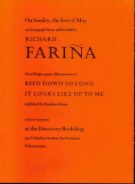 |
June - Mimi moves into an apartment on Alta Street in the Telephone Hill section of San Francisco.
|
2 June - "Dopico" and "Crysanthemum" are copyrighted.
|
13 September - Mimi finally registers her arrangement of "Dog Blue".
|
15 December -"Miles", the first song with Mimi credited as writer, is copyrighted. An instrumental, it is copyrighted with music by Mimi, but also with unrecorded lyrics by Dick. Mimi also copyrights her composition, "Hamish" , from the 1st album.
|
1967
|
Summer - While sister Joan is in the studio recording Joan with help from Peter Schickele's arranging skills, it is likely Joan encouraged Mimi to make use of Schickele's presence in the studio to begin the solo LP for Vanguard that was to be Mimi singing Dick's unrecorded songs (cataloged as VSD-79281, "Richard Fariña"). She records one of Dick's earliest songs, "The quiet joys of brotherhood", later to appear on the posthumous, renamed and recatalogued Memories album. Mimi performs this song in the fall on tv, on what I recall as being a PBS documentary on the music scene. On 30 August, a copyright filters through the Library of Congress for the "London waltz", a song co-authored by Dick and Eric von Schmidt which appeared on their 1963 UK-only album - Dick Farina and Eric von Schmidt. November 14th brings another copyright, this time for Reflections in a crystal wind's "Mainline prosperity blues", copyrighted for inclusion in the posthumous songbook The songs of Richard Fariña.
|
1968
|
April -
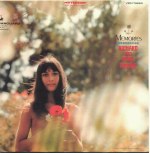 Joan's Baez's single, released in June, 1966 of "Pack up your sorrows" (the A side, though this is not included on the album) and " A Swallow Song", as well as "All the world has gone by" (all produced by Dick for her aborted "rock and roll" album, the latter being co-written by the two), two performances from the Sunday afternoon New Folks concert at Newport in 1965 (not included on the Complete Vanguard Recording sessions, in what was probably a bookeeping error - someone assumed the two were edited from the complete Contemporary Joan's Baez's single, released in June, 1966 of "Pack up your sorrows" (the A side, though this is not included on the album) and " A Swallow Song", as well as "All the world has gone by" (all produced by Dick for her aborted "rock and roll" album, the latter being co-written by the two), two performances from the Sunday afternoon New Folks concert at Newport in 1965 (not included on the Complete Vanguard Recording sessions, in what was probably a bookeeping error - someone assumed the two were edited from the complete Contemporary Song workshop tapes, so figured to include them as issued on the Memories album would be a duplication). Two songs ("Pack up your sorrows" and "Joy 'round my brain" were noted as being "released as singles", which they were; however, not these versions - the singles were shorter, mono, and had different edits and vocals. So these were completely different versions being undersold by Vanguard.
Memories - VSD-79263, released 5/68 - cover photo by Jim Marshall, back photo by David Gahr; design by Jules Halfant. Notes by Maynard Solomon.
|
25 July - Mimi performs opening night at the Newport Folk Festival
|
7 Septmber - Mimi marries San Franciso dj Milan Melvin of KSAN, opening day, Big Sur Festival, Calif.
|
19 November - "All the world has gone by" is copyrighted by Mimi, with "rev. and new lyrics".
|
1969
|
6 January - Copyrights registered for Memories songs " Blood red roses" and the epic "Morgan the pirate"
|
26 May -
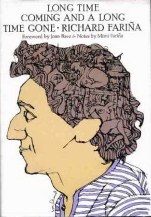 |
1970
|
21 September - One
|
1971
|
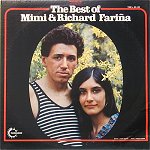 Vanguard releases Vanguard releases Note: Though the double album will originally be released intact on cassette, it will later be reissued and abridged by six songs, as will the eventual CD version, and for that matter, so will most of the Twofer series when they're reissued on CD..
The best of Mimi and Richard Fariña - cover photo by Dan Kramer, inside photos by Kenneth van Sickle ; design by Jules Halfant
|
By 1971, Mimi and Milan Melvin have moved from San Francisco to "somewhere in Big Sur", according to a friend , where they plan to start up their own record label. The label, Struggle Mountain Record Farm, is named after sister Joan's home acreage in Carmel.
|
This timeline was put together from numerous sources, but a great deal was also culled from David Hajdu's Positively 4th Street , currently available (with many more words between dates) in cloth and paper at a bookstore near you. Support your local independent bookseller!
Ó 2002, 2003, 2010 Greg Pennell
Last modified: 26 feb'10
